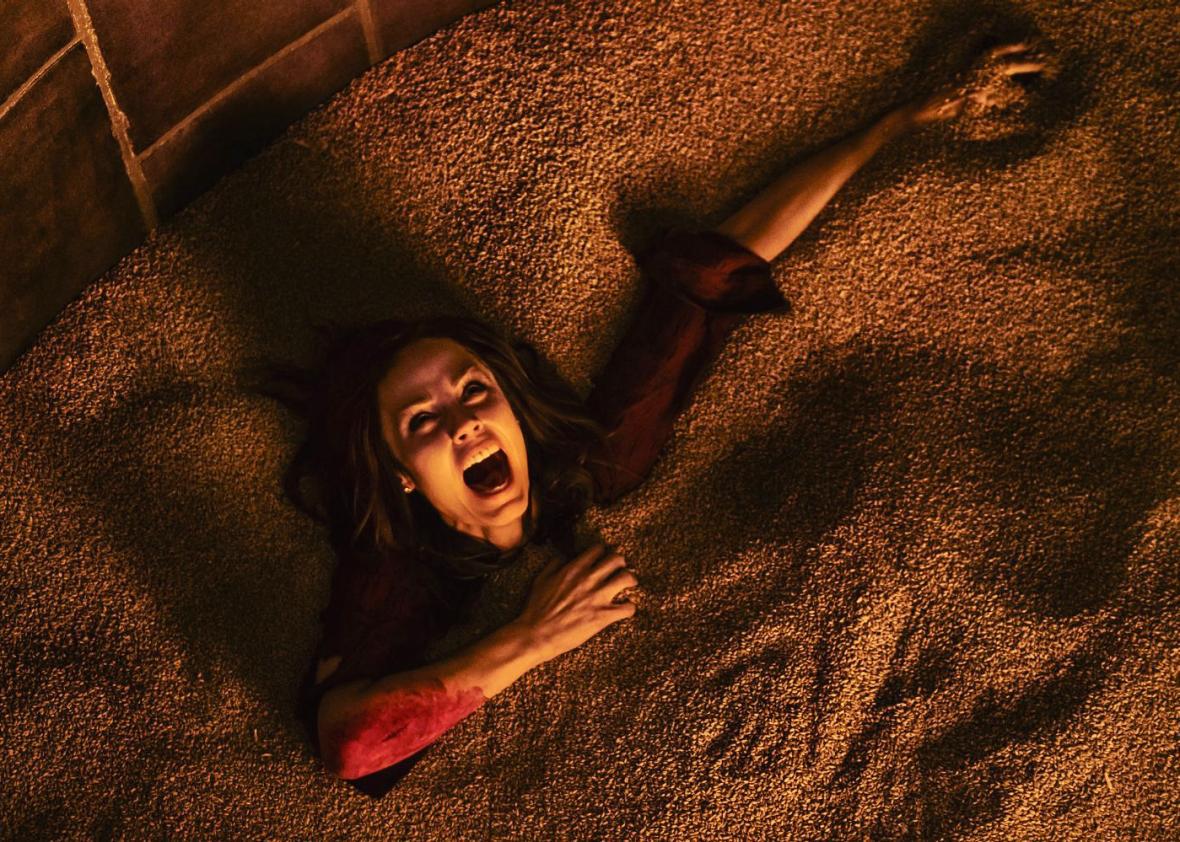Every Halloween from 2004 through 2010, audiences could look forward to a dose of mangled bodies and mutilated corpses on the big screen, courtesy of the Saw franchise. Saw, a low-budget horror film from the (then-)no-name Australian director James Wan and writer Leigh Whannell, grossed $103 million from a budget of $1.2 million beginning in October of 2004, an impressive enough return on its intial investment to eventually spawn six sequels. Then Jigsaw and his clever killer contraptions fell away for a while, with Saw’s numerous sadistic imitators, including Eli Roth’s Hostel and Rob Zombie’s The Devil’s Rejects, evaporating by 2011. In their wake, the subgenre David Edelstein dubbed “torture porn” has been sidelined in favor of a more neoclassical, prestige-drenched approach to horror. Movies like It, The Conjuring, It Follows, Unfriended, Get Out, and the Purge trilogy are considerably less inclined to revel in gore than in dread and sustained suspense. But after seven years, Jigsaw will attempt to restart the Saw franchise this weekend, which makes one wonder: What place does Saw have when mainstream horror cinema, and the world at large, has changed so much?
Watching Saw now feels a bit like getting whiplash from a car crash caused by watching another car crash. It’s shockingly visceral, with a greater sense of the fragility of human flesh than the slasher films of the 1970s and 1980s thanks to the camera’s invasiveness, gawking and leering at the detailed and textured meat in extreme closeups and the production’s grungy minimalism. There’s a fetishistic quality to the way Wan’s camera circles around one of Jigsaw’s victims with a “reverse bear trap” on her head that will tear off her jaw if she doesn’t escape in time. Remember this face, the film tells you. This could be you.
What distinguishes the Saw movies is not merely their elaborate torture devices but the equally convoluted rationale behind them. A cancer survivor, Jigsaw has found new meaning in his life and is disgusted by those who, at least from his perspective, do not value their lives in the same way, a clever inversion of the standard movie narrative where a brush with death gives a character a new lease on life. Any transgression in his moral world—be it drug addiction, adultery, or manslaughter—qualifies his victim for a deadly ordeal that fits their crime.
Movie violence is always political, but in the wake of 9/11, the ramifications of onscreen transgression and punishment became impossible to avoid. The directness of the violence in Saw and its ilk had an edge that implicated filmmaker and audience in a way that phantoms and ghosts could not. But since Saw’s “final chapter,” you have to look outside of theaters to the wilds of genre sidebars and on-demand releases for films of their ilk. In their place, horror films have become less graphic, more outwardly reputable, their demons more mysterious and intangible. Wan’s The Conjuring is technically about a home invasion (by ghosts!), but he opts for a quieter formal approach reminiscent of Jack Clayton’s The Innocents, more atmospheric and interested in conceptual abstractions of fear than the dutiful, bourgeois monsters in Michael Haneke’s 2007 American remake of his own Funny Games. Jordan Peele’s Get Out is less abstract about the roots of its fears, and it’s crucially provocative about liberal and overt racism, but its nightmare is in the atmosphere. Even at its wildest, Get Out is about what you don’t see and what that can take from you. For all its jolts and jump scares, the recent adaptation of Stephen King’s It shies away from the novel’s explicitly political ideas, almost brushing off the book’s interest in homophobia, racism, and misogyny. Its spectacle ends up being more silly than frightening, with the film’s incarnation of the demonic clown Pennywise sliding indiscriminately between creepy and bombastically hilarious.
What’s left in terms of scary movies whose fetishistic love of violence is equaled by their understanding of that violence’s political implications? Try James DeMonaco’s Purge trilogy, set in a near-future U.S. whose ugliest tendencies are vented in an annual holiday where, for the space of a night, “all crime is legal.” The films are not nearly as mired in bloodletting as the torture porn of yore, but there is a precision to who gets killed, and why. The Purge was was a home-invasion thriller also functioned as a critique of upper-class apathy, and the subsequent films have leaned harder on the iconography of marginalization, oppression, and political abuse. 2016’s The Purge: Election Year featured revelers dressed as Uncle Sam and Lady Liberty wielding bats and buzzsaws. “My Country ’Tis of Thee” played in the trailer.
The Saw series’ relationship to violence was marked by the collective trauma of 9/11, but horror movies’ core demographic is now too young to even remember 2001, or in some cases even to have lived through it. Social media has given us an illusory sense of direct interaction with tragedy, whether it’s a natural disaster or a mass shooting, but soon enough the deluge of information leads us on to the next thing. And as our relationship to violence has become more blurred and amorphous, horror movies’ villians have become less physical and more ethereal—more virtual. But if horror, and art in general, can attempt to collectively respond to the current political administration, as Ryan Murphy’s American Horror Story: Cult is trying to do, that may itself justify Jigsaw’s return. Afterall, Saw is a franchise founded upon the idea of one man imposing his moral ethos onto everyone else, a tool of self-mythologizing, with the dream of making America great again.
